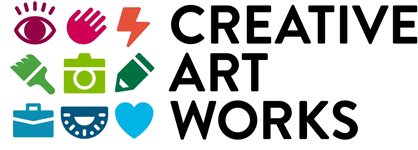The Stories Behind the Masks: Art, Empathy, and Understanding
“This project helped me feel connected to myself. It made me think of my past, my memories, and the experiences that made me who I am today. I feel proud of who I’ve become and that I am true to myself.”
Art has the power to give voice to the unspoken, to bridge divides, and to foster empathy. This truth was encapsulated in the form of a mask crafted by a young artist in a Creative Art Works art lab integrated into the Honors Anatomy & Physiology class at A. Philip Randolph Campus High School.
The objective of the Art Lab is to help sophomores on a medical track forge a deeper understanding of anatomy and physiology by creating paintings, collages, sculptures, and dioramas in response to their science-aligned curriculum. Students at this very vibrant and diverse Title I school self-select for this challenging course and commit to the after-school art lab component.
The inside of the mask represents the brain’s neurons, while the outside represents a coping mechanism or a stress response.
The assignment in question was to paint a mask that tells a story of how the central nervous system works when subjected to stress, of what triggers our body's defense mechanisms, and of the rush of epinephrine that prepares us for “fight or flight.” The back of the mask represents the brain’s neurons, while the front illustrates a coping mechanism or a stress response.
A young artist, a child of Mexican immigrants, told me and a guest who were visiting the class, the story of her daily fears in a climate that often feels hostile to her, and the weight of trying to appear strong and lighthearted for the sake of her younger siblings. She painted the American flag on one side of the mask and the Mexican flag on the other side; in between, she painted jagged black cracks. The mask revealed the internal struggles that she herself often cannot show to the world.
Then, another student stepped forward and shared a painting she had created for a previous assignment in which students had been challenged to paint a self-portrait that illustrates a psychological state. This student, also a child of immigrant parents, chose to illustrate the feeling of dissociative disorder. She said she has struggled to forge societal connections in what she also considers an unwelcoming environment. Then, the first student offered to share her self-portrait which illustrates anxiety. Both paintings are shown below.
Self-portrait illustrating dissociative disorder
Self-portrait illustrating axiety
Both conversations were raw, honest, and deeply moving. What struck me most, in addition to the artistry on display, was the courage the students demonstrated by sharing such vulnerabilities. This speaks to the safe (or we sometimes say “brave”) environment created by CAW Teaching Artist Noga Cohen and APRCHS Science Teacher Christopher Bax, who co-teach both the in-school and after-school sessions of the class.
“These weren’t just art projects; they were acts of bravery. They are a testament to the power of art to create a space for empathy; a space where students feel safe to share their deepest fears and vulnerabilities.”
Many of the students openly expressed their gratitude for this unique class. We are not only proud of them but must also share our thanks to Principal David Fanning and Mr. Bax for their steadfast commitment to this CAW program and our long-term relationship.
Teaching and Program Staff
Teaching Staff
CAW Teaching Artist Noga Cohen
APRCHS Science Teacher Christopher Bax,
Program Staff
CAW Program Manager Kevin Claiborne
Program Manager Donna Manganello
Program Manager of Teaching & Learning Riki Sabel
Operations Coordinator Emilio Vides-Curnen
Program Coordinator Madeline De León
The Creative Art Works Art Lab integrated into the Honors Anatomy & Physiology class at A. Philip Randolph Campus High School is made possible, in part, by the New York State Council on the Arts with the support of the Office of the Governor and the New York State Legislature. This program is also supported, in part, by public funds from the New York City Department of Cultural Affairs in partnership with the City Council. Creative Art Works’ school-based programs also receive support from the Cornelia T. Bailey Foundation.









